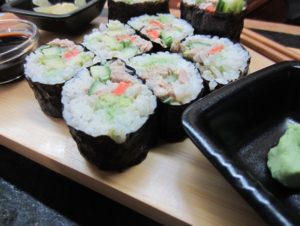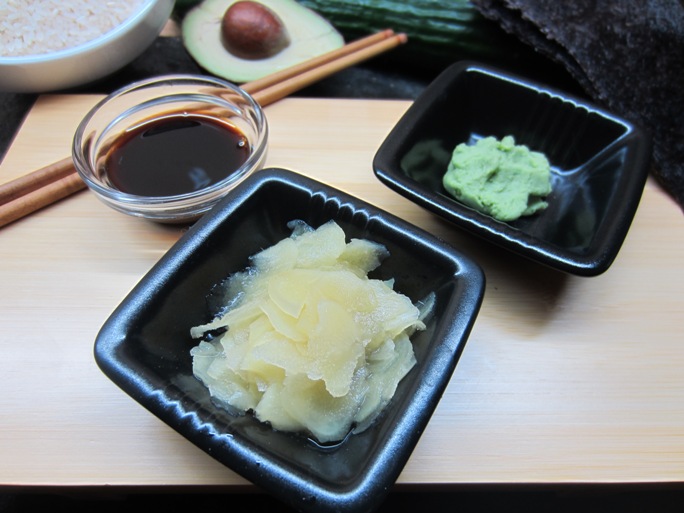Astoundingly, sushi isn’t particularly popular here on the eastern outskirts of Canada despite being surrounded by an ocean full of fresh ingredients. I know many of the uninitiated will scoff at ‘raw fish on rice’ but sushi and sashimi really can be so much more, oftentimes including neither ‘raw’ nor seafood. One market counter here tries to accommodate the brave few with well-made examples – albeit of a drastically limited selection – but it should be telling that when two others tried to crack into the market they both shut down their ‘fresh sushi’ sections within months. Even down in the ‘big city’ the offerings are far below par for what you’d expect in a seaside city of a half million inhabitants.
Up here in the rural sticks this leaves me with a big bowl of sticky rice and no where to turn but my own hands to satisfy the regular spicy tuna (ahi) roll urge. Even back in my west coast days where I found myself sandwiched between decent sushi bars on every other corner, I have been tempting fate with bamboo mats and nori sheets for decades. If sushi making is an art form, I’m still scribbling with crayons and while the results aren’t going to win any beauty contests or impress any skilled Japanese aficionados, they do taste quite good in the end as long as I can find decent ingredients.
I’ll resist ranting about the typically insane legalities they’ve instituted here that prevent me as an individual from buying the freshest fish off the boats (as it should be) and force me to intermediate resellers once again meddling in the free trade mechanisms. I manage to find appropriately fresh “sushi-quality” seafood on occasion which mysteriously seems to coincide with my unpredictable hand roll (temaki) moods. The local scallops (hotate) and lobster (ise-ebi)* at least can be had quickly enough even through the government approved supply chain with the rare bit decent fish finding a way here after regulation-mandated freezing which kills those pesky sea-borne parasites.
* Some linguistic confusion surrounding spiny Japanese lobster versus North American large claw lobsters ensues when trying to translate here.
There are dozens upon dozens of non-raw interpretations of ‘sushi’ such that I think to toss out a whole category of food based on a bit of raw squeemish-ness would be short sighted. Tataki methods lightly sear most any seafood for sushi. A great vegetarian California roll with avocado and wasabi is a lovely thing from time to time as are cooked versions like shrimp or eel known as ebi and inagi respectively. Never mind the hilarity of cornering terrified sushi amateurs into a kitchen to try their hand at rolling. Two decades ago it was just such a dinner party with friends that got my own homemade interest started.
Sticky rice is found easily enough at most any local Megamarket as are nori sheets and rice wine vinegar. Proper wasabi paste is an elusive beast since in North America it’s very often little more than coloured horseradish and mustard but my old spice contacts save the day there and I have a precious stash of the genuine article on hand. I’ve even got it into my head to grow the plants themselves now that the seedlings can be had outside of Japan after centuries of protectionism. I’ll let you know how they turn out in the five or six years it takes to get one to maturity.
The last piece of this taste puzzle is great pickled ginger, known in Japan as gari, which is served alongside sushi and sashimi as a way to clear your palate after each bite. In typical Japanese fashion, rigid etiquette forbids eating the ginger *with* each bite but heretic slackers in the west can have it any way they please I say. The very best examples are freshly made using delicate young ‘spring ginger’ which tends to have a pinkish hue once pickled but that colour is certainly not a requirement. While you might think pink colouring tricks of the commercially prepared versions are there to dupe the unsuspecting, any real sushi connoisseur would spot the difference before the first bite. More likely the Asian flair for all things neon inspired the addition of pink tints in a fit of marketing madness.
In the supply wastelands of deepest Canada there’s nothing on the shelves but abysmal versions laced with fake sweeteners. I’m not sure if it’s an oddity here or a wider trend but most of the brands I see on shelves include the artificial chemical sweetener aspartame which to me completely ruins any lingering shred of taste that might have been left in the ginger. Unless you’re standing in Yokohama where I suspect someone might be packaging the good stuff, avoid pre-made pickled ginger at all costs.
That’s still no excuse to avoid sushi since you can make your own in seconds even without a supply of spring ginger or funny-looking sandal socks. Normal western grocery-supplied ginger root works perfectly well if you shop for uniform unblemished roots. While the temptation is to grab the biggest plumpest knobbly version on offer, that’s typically an older root. It will certainly work but I’ve found it’s worth sifting through the bin to get the narrowest young roots you can find as long as they’re not dried out or overly scarred from the trip to your locale. The skin should be very smooth and tight around the root no matter what thickness is on offer.
You need to peel and cut the roots as part of the process with most common advice suggesting you employ a vegetable peeler and mandoline. Both are less desirable options. For peeling, you need nothing more than an ordinary spoon to scrape the very thin skin from the fresh root. Not only do you save more ginger flesh for use but it’s also a quality check on the root itself. Older tough ginger unsuitable for pickling won’t release the skin well enough for the spoon trick. The mandoline can be used if you’re particularly bad with a knife but the fibrous nature of the roots really makes a full-sized gizmo impractical. I’ve heard everything from hand held truffle shavers to industrial meat slicers suggested to get the thinnest slices for pickled ginger but in reality a freshly sharpened chef’s knife and some Zen patience in slicing can do just as good a job. Take your time, cut across the grain of the fibres, and aim for pieces you can almost see through.
In testing recipes, I found a blanching step often suggested before putting the ginger into the pickling brine improved the texture slightly but sacrificed some of the flavour potency. Instead I simply allow the brine to cool partially before covering the ginger which seems a reasonable half step. If you’re lucky and careful in your ginger root selection I think blanching unnecessary but if you’re stuck with thicker roots in the dead of winter it might be helpful. By all means if you have access to young spring ginger use it and avoid blanching completely. If some latent teen girl urge towards faking pink settles upon you, add a drop of red/pink colouring but know you’re not fooling anyone on the flavour front. It could be green or purple for all I care as long as it tastes good.
Of course pickled ginger can go more places than sushi which makes it worth keeping on hand at all times since it only gets better with time. Minced into tarter sauce is a brilliant and unexpected twist for old standby (homemade please) fish fingers. A sandwich relish made of a few shreds added to olives, onions, and sweet red peppers blitzed in the food processor will leave people guessing the secret ingredient. My coleslaw is similarly laced with tiny amounts of pickled ginger just to keep them wondering why it tastes so good. Just remember that a tiny amount goes a long way.
This recipe is edible after just a few days but really comes into its own after a week sitting in the pickling liquid. Try a slice every day of the first week to see the interesting progression. After your first batch improvise with the sugar/vinegar ratios to achieve your own ginger alchemy and go nuts with additions of chile, garlic, or any other wild idea you might have during tuna-induced madness.

Pickled Ginger at Home
Fresh root ginger, “young spring” examples if available
Rice wine vinegar
Sugar
Sea salt
Scrape off the skin of fresh ginger root using a spoon. If the skin does not easily release, you should source fresher ginger root. With a freshly sharpened knife and being careful to cut across the grain of the root fibres, slice the ginger as thinly as possible, at least 1/16th of an inch if not thinner. Set aside.
In a small sauce pan mix a four-to-one ratio of vinegar to sugar by volume. Add salt to taste.* Heat over medium heat, stirring regularly, just until the sugar has dissolved. Remove from heat to cool to lukewarm. You will need enough to cover the ginger you have prepared in a heavy glass jar that has been sterilized in boiling water for one minute.
* For example, using 1 cup vinegar to 1/4 cup sugar, I add 1/4 teaspoon salt.
Place the ginger slices into the jar and completely cover with the vinegar mix. Tightly seal the jar and refrigerate for at least three days before first use. Best after several weeks and good for months kept in the refrigerator.

